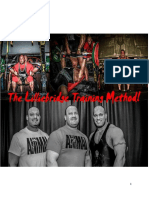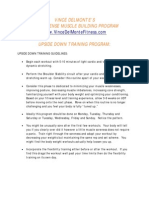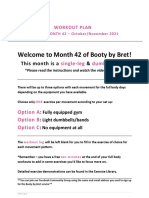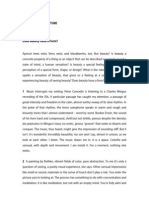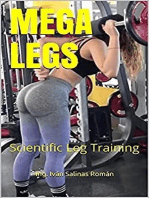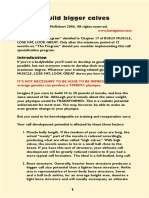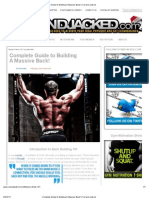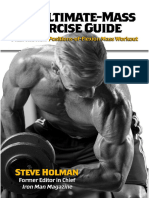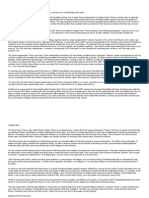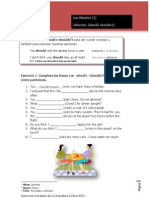Pof Routine
Uploaded by
Nazmus Sadat ShaiekhPof Routine
Uploaded by
Nazmus Sadat ShaiekhPositions of Flexion can be a giant step in helping you reach your muscular potential as quickly as possible.
It s a powerful musclebuilding protocol that's packed as much as 20 pounds of muscle onto bodybuilders frames in as little as 10 weeks. POF is a very logical and straightforward way to train, one that's based on muscle function rather than convention, and it's done near miraculous things for bodybuilders throughout the world. True, as the creator of POF, I am biased, but I've seen it work and I believe it can make your dreams of a more muscular, shredded physique a reality without wasted time and effort, which is why I continue to sing its praises and explain its basic concepts. POF's mass-building power is a direct result of its basic premise: You should choose exercises that train each muscle through its entire range of motion to trigger maximum fiber recruitment, as well as other anabolic mechanisms, at every workout. That means faster, more complete development from fewer sets. Once you grasp its concepts, POF will change the way you train and gain forever. Complete Simulation, Full-Blown Pump When the POF concepts and routines were first introduced in IRONMAN magazine, many bodybuilders were taken by surprise when they put them to the test, commenting that they thought their skin might tear because the influx of blood was so extreme. That's a direct result of the inordinate muscle fiber recruitment that occurs when you train a target muscle through a full range of motion with specific exercises. POF protocol dictates that you use specific exercises to train the entire length of the muscle from full stretch to complete contraction. Before you can give it a test drive and send your own gains skyward, however, you need to grasp POF's underlying concepts and principlesand that understanding starts with uncovering the roots of POF. Justing With Genetics: The Origin of POF POF was a direct result of a number of trainees frustrations in the gym coupled with independent research at the University of Texas at Austin. That research was fueled by the ultimate goal of remedying some of the rampant in-the-gym frustration so many trainees were experiencing. I, for one, was obsessed with research because I wasn't prepared to give up my bodybuilding dreamslowly genetics or not, even though mine were at the bottom of the hardgainer barrel.
When I first started training, I weighed less than 120 pounds. Bad genetics? You bet. In fact, when my parents married in their early 20s, my mother weighed 95 pounds and my father weighed 115. Even with my genetically challenged predisposition, however, I never lost sight of the dream of stepping on a posing platform. I was obsessed and determined to find a muscle-building solution. At the huge state university research materials available were plentiful, to say the least, and I was able to find some applicable physiological truths that helped my progress but only slightly. I was determined to find a better way, so I continued to plow through books, abstracts and studies on anything even remotely related to muscle hypertrophy. My obsession fueled a relentless pursuitand it did eventually pay off. After pouring over hundreds of physiology and biomechanics texts and abstracts, I came across a physiological phenomenon that occurs when a muscle is stretched and then forced to contract soon thereafter. That discovery had me incorporating exercises with a high-stretch component for every bodypart, and I made some decent gains as a direct result. Nevertheless, there was still something missing, and I didn t start packing on real size until after I put the other parts of the puzzle into practiceproperly combining stretch exercises with those that involve synergy, or muscle team work, and peak contraction. That combination constituted full-range-of-motion training that could be applied to every muscle group. As I browsed through a muscle magazine, I noticed that Arnold used a similar approach for his biceps routine: dumbbell curls for synergy, incline curls for stretch and concentration curls for peak contraction. After I tried his programwith less sets, of course, because of my free statusI realized that there was something almost magical about it. After I used his routine for a month, my gym buddies suddenly started asking me to hit arm shots every time I trained because my bi's got more peaked each week. Then once they started using the routine, they got similar results, so I knew it wasn t a fluke. There was something very powerful about that particular exercise combination. With the help of some physiologists at the university, I eventually put together a complete training regimen for each bodypart, and with a prototype version of a POF-based routine my bodyweight shot up to
200 poundsan 80-pound gain from my starting weight; damn good for a -free hardgainerand I soon entered and won my first bodybuilding contest. You may be wondering if you can make similar, or perhaps even better, gains. Absolutely, and the first thing you can do is make sure you re using a stretch-position movement for each muscle group, such as stiff-legged lifts for your hamstrings, donkey calf raises for your calves, pullovers for your lats and overhead extensions for your triceps. [Note: A complete list of stretch-position exercises appears in the Stretch section of this feature.] Ah, but if you re a serious, impatient, muscle-hungry bodybuilder, you probably want the full-blown power of the POF method, not just one little piece, right? Let's analyze each position so you can put all of the pieces into place and start building new muscle size with POF immediately. Dissecting POF With The Austrian Oak POF is a multi-angular bodybuilding protocol that trains a muscle in the three positions that constitute full range of motion (ROM). Understand that it's not simply doing an exercise through its complete stroke, although that's important too. It takes two to three exercises to work a muscle through its complete arc of flexion, or range of motion, which consists of three positions: midrange, stretch and contracted. Arnold's favorite biceps routine is a specific example of standard POF. He often did dumbbell curls, incline dumbbell curls and concentration curls, in that order, a routine that hits his biceps from the three key positions, or angles, for complete ROM: Biceps midrange: upper arms in front of the torso. Dumbbell curls hit the midrange position and train the biceps with synergy, or muscle teamwork, from the front delts. When muscles work together, the overload and fiber activation is much greater in most cases. Stretch: arms behind the torso. Incline dumbbell curls hit the stretch position and activate the myotatic reflex due to inordinate biceps elongation, and the muscle's fiber stimulation is heightened.
Contracted: arms up and away from the torso. Concentration curls hit the contracted position with resistance at the point of maximum contraction. Continuous tension in the fully contracted position provides a potent fiber jolt after the heightened fiber activation created by the previous stretch-position movement. You can see why POF works, and why it creates a skin-stretching pump in only a few sets. You totally stimulate the muscle fibers by triggering the stretch reflex as part of a routine that trains each bodypart through its complete range of motion, or arc of flexion. Muscle physiology dictates that full ROM and the myotatic reflex will combine to ignite an extreme hypertrophic adaptation, especially after a compound, or midrange, exercise that overloads the target muscle due to synergy, or help from other muscle groups. Let's start from the top, with the midrange position. Midrange Position: Training the Mass of he Muscle The first exercise in a standard POF approach is a midrange movement. These exercises are known as the mass-builders because they train the majority of the target-muscle fibers with heavy weight, so it makes sense to give them priority most of the time. Midrange movements involve synergy, or muscle team work, which means that a number of muscle structures work together, with the target muscle as the prime mover. For example, the squat is a midrange exercise for the quads, and the glutes, hamstrings, lower back and even calves get in on the action to help the quads elevate heavy iron. You can see why these exercises are at the core of every POF bodypart routinethey build mass, plain and simple. Here's a list of some of the best midrange movements for each odypart: Quads: squats Hamstrings: stiff-legged lifts (also a stretch movement) Lats: wide-grip chins to the front Midback: behind-the-neck pulldowns
Delts: dumbbell presses Chest: bench presses Biceps: barbell curls or close-grip undergrip pulldowns Triceps: lying extensions or close-grip bench presses Abdominals: kneeups Synergy allows you to cultivate tremendous power because muscles work most efficiently as part of a team. POF midrange movements all have synergy, and using those exercises alone for each bodypart can build phenomenal muscle size and strength. You can get even better results, though, when you follow your midrange exercises with movements for the other two target-muscle positions, stretch and contracted. S e ch: Eme genc Re pon e o Re i e Coma o e Fibe Stretch-position movements, the second exercise in standard POF protocol, activate the myotatic reflex. Training the target bodypart at its maximal point of elongation, for example incline curls for the biceps or overhead extensions for the triceps, can force an emergency response from the muscle and bring new muscle fibers into play. Here is how the phenomenon is defined in the book e Power by Health For Life: The stretch reflex originates deep inside each muscle fiber with a structure called the muscle spindle. The muscle spindle is a complex construction of muscle protein, fluid and nervous system receptors. Within this structure is a special type of muscle fiber that does not have the contractile qualities normally associated with muscle. These special fibers, called intrafusal fibers, are wrapped with nerve cells that relay information from muscle to the central nervous system. When a muscle is stretched quickly, the tension in the intrafusal fibers stimulates these nerve cells, sending messages out to the central nervous system at great speed. In response, the central nervous system triggers a muscle reflex that generates a fast and powerful contraction. This myotatic, or stretch, reflex is a protective mechanism that provides an extra burst of strength to resist force encountered suddenly. When the reflex is triggered, a very large proportion of the muscle's fibers suddenly contract.
When you use a stretch-position exercise, such as flyes for the chest or pullovers for the lats, the target muscle reacts with an emergency response, which can trigger more muscle fibers to fire. The reason an emergency reaction occurs is that you re training the muscle in a somewhat vulnerable positionat a point of full elongation. By activating more fast-twitch fibers in the target muscle, you stimulate faster development. Stretch-position exercises may also enlarge the fascia, or fiber encasements, so that fiber growth isn t constricted and they also may trigger more anabolic hormone release. Stretch-position exercises are very important for optimal hypertrophic stimulation. Here's a list of stretch-position exercises for each muscle group: Quads: sissy squats Hamstrings: stiff-legged lifts Calves: donkey calf raises Abs: cable crunches with low-back support Chest: dumbbell flyes Lats: pullovers Midback: close-grip cable rows Delts: incline one-arm laterals Biceps: incline curls Triceps: overhead extensions You'll really feel these exercises in the target muscle, especially when you do them after a big midrange movement. The pump and burn will be unrealand in some cases almost unbearablebut you re not done yet. To finish off the target muscle and complete the full-ROM chain, you follow the stretch-position exercise with a contracted-position movement for that final growth jolt. Con ac ed: Peak Con ac ion fo a Sea ing G o h Reac ion
The last exercise in any standard POF bodypart routine is the contracted-position movement, which trains the target bodypart at the point of complete contraction with resistancefor example, leg extensions for the front thighs. An exercise with resistance in the completely contracted position is the best way to finish off a target muscle after as many fibers as possible have been activated with the midrange- and stretch-position movements. Here s a list of contracted-position exercises for each muscle group: Quads: leg extensions Hamstrings: leg curls Calves: standing calf raises Abs: full-range crunches Chest: cable flyes or pec deck flyes Lats: stiff-arm pulldowns or pullover machine Midback: bent-arm bent-over rows Delts: lateral raises Biceps: concentration curls or double-biceps cable curls Triceps: one-arm pushdowns or kickbacks Okay, let's put it all together so you can start using POF programs at your very next workout. POF: Total Target-Muscle Stimulation for Extraordinary Mass Gains The underlying concept of POF is simple: If you hit a muscle from a number of angles, you stimulate more fibers, and if you use a stretchposition exercise correctly as part of the full-ROM approach, you bring even more of the muscle into play; however, if you understand POF, you know the angles shouldn t be randomthey should complement one another so together they complete the full-ROM chain. For example, you saw that Arnold's biceps routine trains the target
muscle as follows: upper arms slightly in front of the torso, with dumbbell curls (midrange) upper arms back behind the torso, with incline curls (stretch) upper arm up and away from the torso with concentration curls (contracted) Each position can involve different fibers and different recruitment patterns, which produce fuller development. It's why advanced bodybuilders do more than one exercise per bodypartto develop as many fibers as possible to extreme degrees. Keep in mind, however, that a lot of advanced bodybuilders use the shotgun approach when it comes to multiangular training, with no rhyme or reason to exercise selection, which can lead to overlap, wasted effort and overtraining. POF's logical structure can help you avoid that pitfal. Top Full-rangeof-motion POF training works because it produces almost complete target-muscle stimulation with the minimal amount of work necessary for the exercises that complete the full-ROM chain. If you re still not convinced multiangular training is necessary, consider the following quote from Jaci VanHeest, renowned exercise physiologist at the U.S. Olympic Training Center in Colorado Springs, Colorado: Muscles contract when tiny levers on myosin, a muscle protein, fit into grooves on actin, another protein, and push it forward exactly like a ratchet wrench. But myosin can latch onto actin in any of several positions, not all of them ideal. Only when the myosin heads are in the right register can the muscle have the optimal tension. But optimizing every actin-myosin pairing is less an achievable goal than a Platonic ideal. (Newsweek, July 22, 1996: How High? How Fast?) You need more than one exercise to optimize as many actin-myosin pairings in the target muscle as possible, and full ROM training like POF is the logical answer to that optimization. Here is another example, with triceps as the target: Midrange Close-grip bench presses or lying extensions 2 x 7-10
Stretch Overhead extensions 2 x 7-10 Contracted One-arm pushdowns or kickbacks 2 x 7-10 You first work the midrange position with close-grip bench presses. Remember, midrange equals synergy, in this case teamwork from your front delts, pecs and lats. Next is the stretch position, which you train with overhead extensions. That exercise forces maximum elongation and triggers the myotatic reflex. You use kickbacks, a contracted-position exercise, last in order to work the triceps at the point of complete contraction with resistance. Note that it only takes one to two sets of each exercisefour to six total sets per bodypart to train the target muscle completely and thoroughly. The low perbodypart set total means that more of your recovery ability is available for ramping up recuperation and anabolic acceleration after your workout, while overtraining is kept at bay. If you want to give your delts the full-ROM treatment with POF, try the following: Midrange Behind-the-neck presses 2 x 7-10 Stretch Incline one-arm laterals 2 x 7-10 Contracted Seated laterals 2 x 7-10 Notice that you train the lateral heads with synergy during behind-theneck pressesyour delts work in conjunction with triceps and traps to push the bar overheadyou work the medial head in the stretch position with incline one-arm lateralsyour arm moves down and across your bodyand you train the side head in its peak-contracted position against resistance with lateral raises. Your delts have no
choice but to grow rounder and fuller with this type of multi-angular full-ROM approach. With the above suggestions, you should be able to grow faster and with fewer sets than with any training protocol you've ever tried. The chest is somewhat more complicated. Due to its fan shape you divide it into two sections, upper and lower/middle; however, you can train two positions with one exercise. For lower/middle chest flat bench presses train the target muscle with other muscle groups (synergy in the midrange position). Cable crossovers (or Nautilus flyes) train the pecs from full stretch to complete contraction, with resistance in the contracted position. Notice that the lower/middle chest takes only two precise exercises to hit the full arc of flexion. You can get the same two-for-one effect when you train the upper portion: Use incline presses for the midrange position and incline cable flyes for the stretch and contracted positions. Now you have a tremendously effective POF pecbuilding routine. Middle/lower-pec section Midrange Bench presses 2 x 7-10 Stretch and contracted Cable crossovers 2 x 7-10 Upper-pec section Midrange Incline bench presses 2 x 7-10 Stretch and contracted Incline cable flyes 2 x 7-10 You have to realize that you need more than one exercise to optimize as many actin-myosin pairings in the target muscle as possible, and you want to choose the movements that together take the target
muscle through its full range of motion. That means working from full stretch to complete contraction, plus training the muscle with synergy. To accomplish that it may take two or three movements, depending on the exercises you choose. Let's look at one last example. Here are POF quad and hamstring routines with a bit more explanation than the other programs, just in case you haven t quite got the full-POF picture yet: Midrange position Squats (synergy from glutes and lower back) Do 2 light warmup sets first), then 2-3 x 8-12 Stretch position Sissy squats or Feet-forward Smith machine squats Quick twitch out of the bottom, when hamstrings touch your calves 2 x 10 Contracted position Leg extensions Hold for a count at the top to emphasize peak contraction 1-2 x 8-12 Hamstrings, on the other hand, only require two exercises for fullrange training to fully optimize the actin-myosin pairings and stimulate inordinate growth. As you saw with chest, sometimes one exercise will cover two of the Positions of Flexion. In the following program, it's the stiff-legged lift: Midrange and stretch positions Stiff-legged lifts (synergy from glutes and lower back, plus full stretch at the bottom of each rep) Do 2 light warmup sets, then 2-3 x 8-10 Contracted position Leg curls
Hold for a count at the top to emphasize peak contraction 2 x 8-12 You can develop your own POF routines for other bodyparts by taking an exercise from each of the lists in the sections above and doing one to three sets of each. Positions of Flexion is undoubtedly one of the most logical, efficient muscle-building methods out there. It's helped a multitude of bodybuilders push beyond their so-called genetic limitations, and it can do the same for you. Try it in its standard forms or one of its many hybrid protocols, such as Hypercontraction training or Compound Aftershock. If you've never tried POF, be prepared for some unusual sorenessand some exciting new muscle growth. You'll soon see why it's becoming an integral part of so many successful bodybuilders training arsenals the world over.
You might also like
- Excerpt From "Between Breaths" by Elizabeth VargasNo ratings yetExcerpt From "Between Breaths" by Elizabeth Vargas3 pages
- Mr. Germany, Mr. Europe, Mr. Universe And Mr. America Ben Huellen Raw, The Good, The Bad And Certainly The Ugly.From EverandMr. Germany, Mr. Europe, Mr. Universe And Mr. America Ben Huellen Raw, The Good, The Bad And Certainly The Ugly.No ratings yet
- Welcome To Month 42 of Booty by Bret!: This Month Is A & PlanNo ratings yetWelcome To Month 42 of Booty by Bret!: This Month Is A & Plan15 pages
- Steve Holman & Jonathan Lawson - The Ultimate Mass WorkoutNo ratings yetSteve Holman & Jonathan Lawson - The Ultimate Mass Workout136 pages
- Bodybuilding Routines For Complete Recovery100% (2)Bodybuilding Routines For Complete Recovery4 pages
- The Tight Tan Slacks of Dezso Ban - Routines I Have Used - Clarence RossNo ratings yetThe Tight Tan Slacks of Dezso Ban - Routines I Have Used - Clarence Ross5 pages
- The Tight Tan Slacks of Dezso Ban - The Architecture of Big Arms, Part Three - Todd - AndersonNo ratings yetThe Tight Tan Slacks of Dezso Ban - The Architecture of Big Arms, Part Three - Todd - Anderson6 pages
- 6 Week Hercules Workout - Build A Powerful, Commanding & Functional Physique - Muscle & StrengthNo ratings yet6 Week Hercules Workout - Build A Powerful, Commanding & Functional Physique - Muscle & Strength17 pages
- Dennis B. Weis - 3 Sleeve Splitting Routines100% (5)Dennis B. Weis - 3 Sleeve Splitting Routines40 pages
- Muscle Sculpting Workout (Pha) 2 Dave Bishop100% (2)Muscle Sculpting Workout (Pha) 2 Dave Bishop3 pages
- The Best Way To Train For Size by Walter EddyNo ratings yetThe Best Way To Train For Size by Walter Eddy4 pages
- Ben Pakulski MI40 Report - 5 Tricks To Double Your GainsNo ratings yetBen Pakulski MI40 Report - 5 Tricks To Double Your Gains43 pages
- An81z0jj - 94y wwrPCu5qM3XQ8gwUvNTeNKer pWsBiqu9ufVad9pSpfmXegsN7Gh 3o - 2GUFF97rtPz8iODz34uiSv74 - lnGoOpFoNlSpZd4FoXUSO 4Cm6BU8pXw PDFNo ratings yetAn81z0jj - 94y wwrPCu5qM3XQ8gwUvNTeNKer pWsBiqu9ufVad9pSpfmXegsN7Gh 3o - 2GUFF97rtPz8iODz34uiSv74 - lnGoOpFoNlSpZd4FoXUSO 4Cm6BU8pXw PDF72 pages
- Complete Guide To Building A Massive Back! - Cut and JackedNo ratings yetComplete Guide To Building A Massive Back! - Cut and Jacked7 pages
- Dual Factor Hypertrophy Training by Matt ReynoldsNo ratings yetDual Factor Hypertrophy Training by Matt Reynolds5 pages
- Ladies We'Ve Got This Covered The Man RulesNo ratings yetLadies We'Ve Got This Covered The Man Rules2 pages
- [FREE PDF sample] Bodybuilding Anatomy 2 ed 2nd Edition Evans Nicholas ebooks100% (2)[FREE PDF sample] Bodybuilding Anatomy 2 ed 2nd Edition Evans Nicholas ebooks40 pages
- Mega Mass “Your Foundation For: Building Muscle, Staying Lean, & Breaking Plateaus”: Fitness Package, #1From EverandMega Mass “Your Foundation For: Building Muscle, Staying Lean, & Breaking Plateaus”: Fitness Package, #1No ratings yet
- How To Get 18-Inch Arms Without Steroids: An Interview With A Natural BodybuilderFrom EverandHow To Get 18-Inch Arms Without Steroids: An Interview With A Natural Bodybuilder2/5 (1)
- Final 24-10-24 Rapid Dec Prize Lakecity OpenNo ratings yetFinal 24-10-24 Rapid Dec Prize Lakecity Open12 pages
- 2012 Fall Trafalgar Square Publishing Children's BooksNo ratings yet2012 Fall Trafalgar Square Publishing Children's Books124 pages
- Bill Evans How My Heart Sings Pettinger - Download the ebook now and read anytime, anywhere100% (1)Bill Evans How My Heart Sings Pettinger - Download the ebook now and read anytime, anywhere47 pages
- Unleashing The Power of Raspberry Pi 400No ratings yetUnleashing The Power of Raspberry Pi 4006 pages
- Investments An Introduction 12th Edition by Herbert B. Mayo download pdfNo ratings yetInvestments An Introduction 12th Edition by Herbert B. Mayo download pdf34 pages
- Excerpt From "Between Breaths" by Elizabeth VargasExcerpt From "Between Breaths" by Elizabeth Vargas
- Mr. Germany, Mr. Europe, Mr. Universe And Mr. America Ben Huellen Raw, The Good, The Bad And Certainly The Ugly.From EverandMr. Germany, Mr. Europe, Mr. Universe And Mr. America Ben Huellen Raw, The Good, The Bad And Certainly The Ugly.
- Welcome To Month 42 of Booty by Bret!: This Month Is A & PlanWelcome To Month 42 of Booty by Bret!: This Month Is A & Plan
- Steve Holman & Jonathan Lawson - The Ultimate Mass WorkoutSteve Holman & Jonathan Lawson - The Ultimate Mass Workout
- The Tight Tan Slacks of Dezso Ban - Routines I Have Used - Clarence RossThe Tight Tan Slacks of Dezso Ban - Routines I Have Used - Clarence Ross
- The Tight Tan Slacks of Dezso Ban - The Architecture of Big Arms, Part Three - Todd - AndersonThe Tight Tan Slacks of Dezso Ban - The Architecture of Big Arms, Part Three - Todd - Anderson
- 6 Week Hercules Workout - Build A Powerful, Commanding & Functional Physique - Muscle & Strength6 Week Hercules Workout - Build A Powerful, Commanding & Functional Physique - Muscle & Strength
- Ben Pakulski MI40 Report - 5 Tricks To Double Your GainsBen Pakulski MI40 Report - 5 Tricks To Double Your Gains
- An81z0jj - 94y wwrPCu5qM3XQ8gwUvNTeNKer pWsBiqu9ufVad9pSpfmXegsN7Gh 3o - 2GUFF97rtPz8iODz34uiSv74 - lnGoOpFoNlSpZd4FoXUSO 4Cm6BU8pXw PDFAn81z0jj - 94y wwrPCu5qM3XQ8gwUvNTeNKer pWsBiqu9ufVad9pSpfmXegsN7Gh 3o - 2GUFF97rtPz8iODz34uiSv74 - lnGoOpFoNlSpZd4FoXUSO 4Cm6BU8pXw PDF
- Complete Guide To Building A Massive Back! - Cut and JackedComplete Guide To Building A Massive Back! - Cut and Jacked
- [FREE PDF sample] Bodybuilding Anatomy 2 ed 2nd Edition Evans Nicholas ebooks[FREE PDF sample] Bodybuilding Anatomy 2 ed 2nd Edition Evans Nicholas ebooks
- Smart Muscle: Physical Training Guide for Busy PeopleFrom EverandSmart Muscle: Physical Training Guide for Busy People
- Mega Mass “Your Foundation For: Building Muscle, Staying Lean, & Breaking Plateaus”: Fitness Package, #1From EverandMega Mass “Your Foundation For: Building Muscle, Staying Lean, & Breaking Plateaus”: Fitness Package, #1
- How To Get 18-Inch Arms Without Steroids: An Interview With A Natural BodybuilderFrom EverandHow To Get 18-Inch Arms Without Steroids: An Interview With A Natural Bodybuilder
- Diamond Cut Six Packs!: How to Develop Fantastic Abs!From EverandDiamond Cut Six Packs!: How to Develop Fantastic Abs!
- 2012 Fall Trafalgar Square Publishing Children's Books2012 Fall Trafalgar Square Publishing Children's Books
- Bill Evans How My Heart Sings Pettinger - Download the ebook now and read anytime, anywhereBill Evans How My Heart Sings Pettinger - Download the ebook now and read anytime, anywhere
- Investments An Introduction 12th Edition by Herbert B. Mayo download pdfInvestments An Introduction 12th Edition by Herbert B. Mayo download pdf




